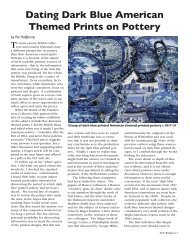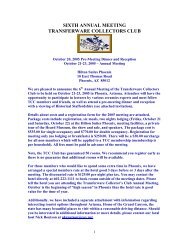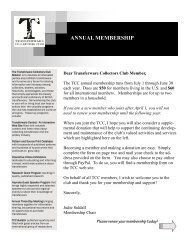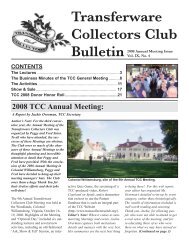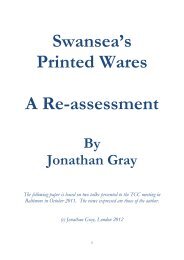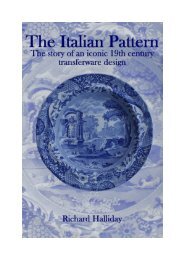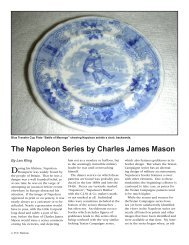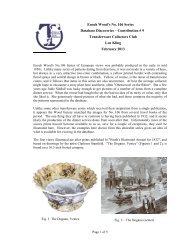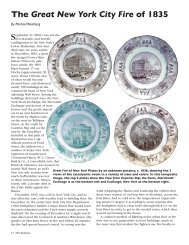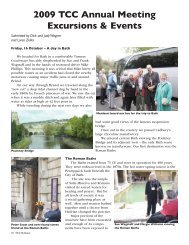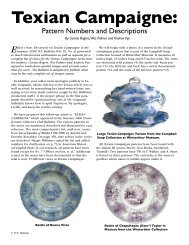download the publication - Transferware Collectors Club
download the publication - Transferware Collectors Club
download the publication - Transferware Collectors Club
You also want an ePaper? Increase the reach of your titles
YUMPU automatically turns print PDFs into web optimized ePapers that Google loves.
CONCLUSION<br />
Although we are no experts on copper plate engraving we have been able,<br />
by judicious research, to ascertain salient facts about <strong>the</strong> process. Copper<br />
plates had advantages over steel engraving plates from an aes<strong>the</strong>tic point<br />
of view. Only about two hundred and fifty impressions could be obtained<br />
from a copper plate before some reworking or repairing would be required.<br />
Copper plates were easier to engrave than steel; in fact much harder tools<br />
were required to engrave steel. This ease of engraving on copper allowed<br />
more freedom in <strong>the</strong> effects that could be produced. Also <strong>the</strong> lines that<br />
could be produced were softer and not as fine or as hard-edged as those on<br />
steel, thus providing a richer, warmer feel to <strong>the</strong> print than could be<br />
obtained from a steel plate. Copper plates had <strong>the</strong> advantage of being<br />
easier to alter. All one had to do was to reheat <strong>the</strong> copper plate and beat<br />
flat <strong>the</strong> area to be changed, polish it and re-engrave. To some extent this<br />
can explain variations in impressions/patterns on pottery.<br />
One online printing firm* illustrates an image of an engraver of 1805<br />
working at a table with <strong>the</strong> source image propped up in such a way that it<br />
can be viewed in a mirror. He is, of course, engraving for printing on<br />
paper. Engraving a copper for pottery is, of course, always done as it will<br />
show on <strong>the</strong> pot so no mirror image is required. According to <strong>the</strong><br />
Worcester Porcelain Museum website* transfer printed designs were<br />
created by punching dots and engraving/cutting fine lines. This was an<br />
exhausting and lengthy process The Museum states authoritatively that to<br />
engrave a ten-inch copper plate, depending on its complexity, would take<br />
an engraver some 40 hours to complete. This does agree with our earlier<br />
estimate of approximately five days to finish a copper plate engraving.<br />
Clearly in <strong>the</strong> 4½ years that Rothwell was in Swansea, not taking into<br />
account <strong>the</strong> time he spent on <strong>the</strong> topographical engravings he did for paper<br />
and plaster, his engravings for Swansea pottery must have been<br />
considerable. We have not included all <strong>the</strong> work attributed to Rothwell by<br />
previous experts and obviously <strong>the</strong>re must be o<strong>the</strong>r patterns of his awaiting<br />
attribution.<br />
We apologise to anyone who knows o<strong>the</strong>r examples of Rothwell’s work<br />
we have not included. We have only included a selection of his work as<br />
attributed by o<strong>the</strong>r experts and a few we feel we have reason for crediting<br />
to Rothwell also.<br />
61



